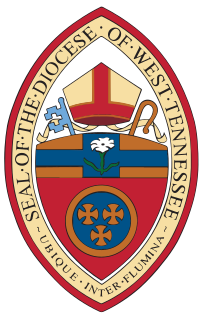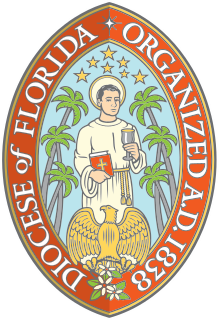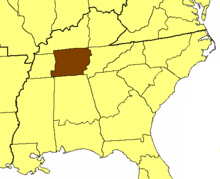
The Episcopal Diocese of Alabama is located in Province IV of the Episcopal Church and serves the state of Alabama with the exception of the extreme southern region, including Mobile, which forms part of the Diocese of the Central Gulf Coast. The latter body was formed in 1970 from portions of the territories of the Diocese of Alabama and the Diocese of Florida.

The Episcopal Diocese of Louisiana is the diocese of the Episcopal Church in the eastern part of the state of Louisiana. The see city is New Orleans.

The Episcopal Diocese of Georgia, USA is one of 20 dioceses that comprise Province IV of the US Episcopal Church, and is a diocese within the worldwide Anglican Communion. The current bishop is Frank S. Logue, who succeeded Scott Anson Benhase on May 30, 2020 when he was consecrated 11th Bishop of Georgia at a service held in Christ Church in Savannah, Georgia.

The Episcopal Diocese of Pittsburgh is a diocese in the Episcopal Church in the United States of America. Geographically, it encompasses 11 counties in Western Pennsylvania. It was formed in 1865 by dividing the Episcopal Diocese of Pennsylvania. The diocesan cathedral is Trinity Cathedral in downtown Pittsburgh. The Rt. Rev. Ketlen A. Solak was consecrated and seated as its current bishop in autumn 2021.

The Episcopal Diocese of West Tennessee is the diocese of the Episcopal Church that geographically coincides with the political region known as the Grand Division of West Tennessee. The geographic range of the Diocese of West Tennessee was originally part of the Episcopal Diocese of Tennessee, which was partitioned into three separate dioceses during 1982–1985. Phoebe A. Roaf is the current bishop of West Tennessee. It is headquartered in Memphis, Tennessee on the close of St. Mary's Cathedral.

The Episcopal Diocese of the Central Gulf Coast is a diocese of the Episcopal Church in the United States of America, part of Province 4. The diocese was created in 1970 from portions of the adjoining dioceses of Alabama and Florida.

The Episcopal Diocese of Oklahoma dates back to 1837 as a Missionary District of the Episcopal Church in the United States of America. The General Convention of the Episcopal Church recognized The Diocese of Oklahoma in 1937. The diocese consists of all Episcopal congregations in the state of Oklahoma. The ninth Bishop and sixth diocesan Bishop is Poulson C. Reed, consecrated in 2020.
The Anglican realignment is a movement among some Anglicans to align themselves under new or alternative oversight within or outside the Anglican Communion. This movement is primarily active in parts of the Episcopal Church in the United States and the Anglican Church of Canada. Two of the major events that contributed to the movement were the 2002 decision of the Diocese of New Westminster in Canada to authorise a rite of blessing for same-sex unions, and the nomination of two openly gay priests in 2003 to become bishops. Jeffrey John, an openly gay priest with a long-time partner, was appointed to be the next Bishop of Reading in the Church of England and the General Convention of the Episcopal Church ratified the election of Gene Robinson, an openly gay non-celibate man, as Bishop of New Hampshire. Jeffrey John ultimately declined the appointment due to pressure.

The Episcopal Diocese of East Tennessee is the diocese of the Episcopal Church that geographically coincides with the political region known as the Grand Division of East Tennessee. The geographic range of the Diocese of East Tennessee was originally part of the Episcopal Diocese of Tennessee, which was partitioned into three separate dioceses during 1982–1985. It is headquartered in Knoxville, Tennessee.

The Episcopal Diocese of the Rio Grande is the Episcopal Church's diocese in New Mexico and southwest Texas, the portion of the state west of the Pecos River, including the counties of El Paso, Reeves, Culberson, Jeff Davis, Brewster, Presidio, Terrell, Hudspeth and Pecos. The total area of the diocese is 153,394 square miles (397,290 km2). According to the 2006 parochial report, there are 57 active congregations within the diocese. The see is based in Albuquerque, New Mexico and the diocesan cathedral is the Cathedral Church of St. John.

St. Mary's Episcopal Cathedral, designed by Memphis architect Bayard Snowden Cairns, located near downtown Memphis, Tennessee, is the cathedral church of the Episcopal Diocese of West Tennessee and the former cathedral of the old statewide Episcopal Diocese of Tennessee.

The Episcopal Diocese of Florida is a diocese of the Episcopal Church in the United States of America (ECUSA). It originally comprised the whole state of Florida, but is now bounded on the west by the Apalachicola River, on the north by the Georgia state line, on the east by the Atlantic Ocean and on the south by the northern boundaries of Volusia, Marion, and Citrus counties. Its cathedral church is St. John's Cathedral in Jacksonville.
The Anglican Diocese of Pittsburgh is a diocese of the Anglican Church in North America. It has parishes in the several counties of Western Pennsylvania. In addition, the diocese has oversight of several parishes that are not located within its geographical boundaries, including three in Illinois, two in Tennessee, and one in Colorado. The diocese also has a parish in Mexico.
Bertram Nelson Herlong was the tenth bishop of the Episcopal Diocese of Tennessee.
John Crawford Bauerschmidt is an American prelate of the Episcopal Church who is the eleventh and current Bishop of Tennessee.
Brice Sidney Sanders was sixth bishop of the Episcopal Diocese of East Carolina between 1983 till 1997.

John Vander Horst was bishop of the Episcopal Diocese of Tennessee from 1961 to 1977.

William Evan Sanders was an American Episcopalian bishop. He was the eighth bishop of the Episcopal Diocese of Tennessee from 1977 to 1985, and first bishop of the Episcopal Diocese of East Tennessee from 1985 to 1992. He was consecrated to the episcopate on April 4, 1962.
Furman Charles "Bill" Stough was an American prelate who served as the eighth Episcopal Church Bishop of Alabama from 1971 till 1988.
James Malone Coleman was second bishop of the Episcopal Diocese of West Tennessee. Coleman was the first bishop of any Tennessee diocese to actually be born inside the state itself.






















